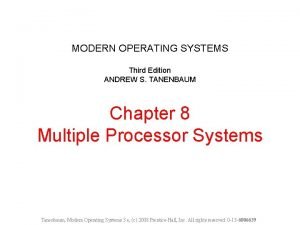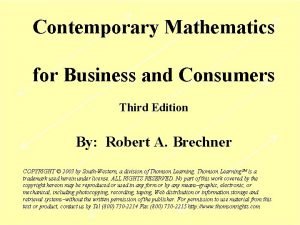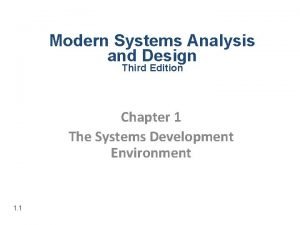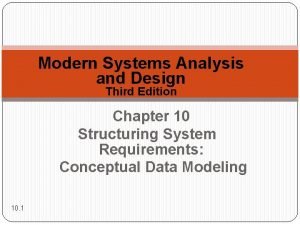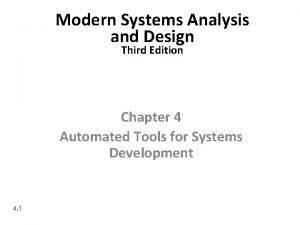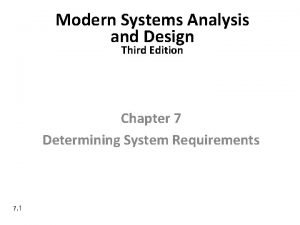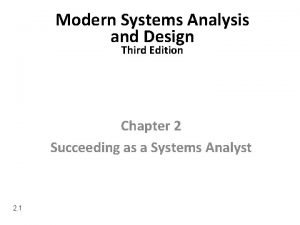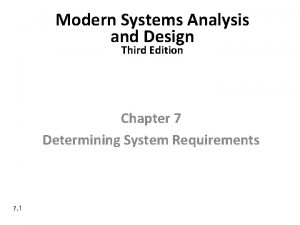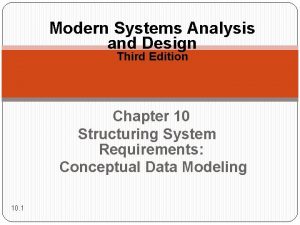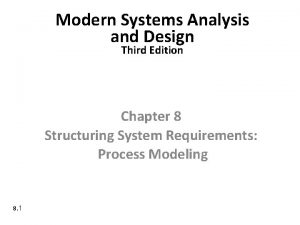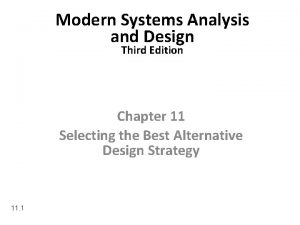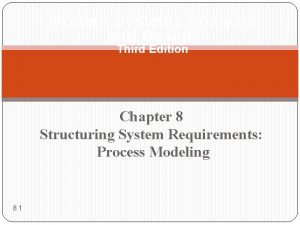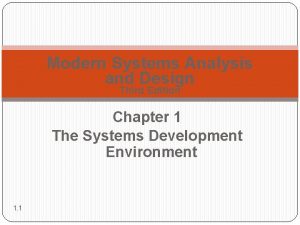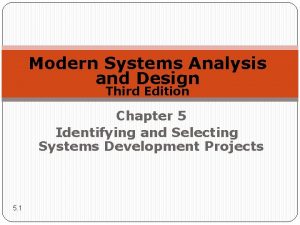Modern Systems Analysis and Design Third Edition Chapter













- Slides: 13

Modern Systems Analysis and Design Third Edition Chapter 11 Selecting the Best Alternative Design Strategy 11. 1

Selecting the Best Alternative Design Strategy • Two basic steps 1. Generate a comprehensive set of alternative design strategies 2. Select the one design strategy that is most likely to result in the desired information system • Process – – – 11. 2 Divide requirements into different sets of capabilities Enumerate different potential implementation environments that could be used to deliver the different sets of capabilities Propose different ways to source or acquire the various sets of capabilities for the different implementation environments

Selecting the Best Alternative Design Strategy • Deliverables 1. At least three substantially different system design strategies for building the replacement information system 2. A design strategy judged most likely to lead to the most desirable information system 3. A Baseline Project Plan (BPP) for turning the most likely design strategy into a working information system 11. 3

Generating Alternative Design Strategies • Best to generate three alternatives – Low-end • Provides all required functionality users demand with a system that is minimally different from the current system – High-end • Solves problem in question and provides many extra features users desire – Midrange • Compromise of features of high-end alternative with frugality of low-end alternative 11. 4

Drawing Bounds on Alternative Designs • Minimum Requirements – Mandatory features versus desired features – Forms of features • • 11. 5 Data Outputs Analyses User expectations on accessibility, response time

Drawing Bounds on Alternative Designs • Constraints on System Development – Date when system is needed – Financial and human resources – Elements of the system that cannot change – Legal and contractual considerations 11. 6

Issues to Consider in Generating Alternatives • Outsourcing – The practice of turning over responsibility of some to all of an organization’s information systems applications and operations to an outside firm – Can provide a cost effective solution 11. 7

Issues to Consider in Generating Alternatives • Sources of Software – Hardware manufacturers – Packaged software producers – Custom software producers – Enterprise solution software – Application Service Providers – In-house development 11. 8

Criteria for Choosing Off-the-Shelf Software • Cost • Functionality • Vendor Support – Installation – Training – Technical Support • Viability of Vendor 11. 9

Criteria for Choosing Off-the-Shelf Software • Flexibility – Ease of customization • Response Time • Ease of Installation 11. 10

Validating Purchased Software Information • Information from vendor – Request for proposal • • 11. 11 A document provided to vendors to ask them to propose hardware and system software that will meet the requirements of your new system Software evaluation period Customer references from vendor Independent software testing service

Hardware and Software Issues Existing Platform 1. Lower costs 2. Information system staff is familiar with operation and maintenance 3. Increased odds of successfully integrating system with existing applications 4. No added costs of converting old systems to new platform or transferring data 11. 12 New Hardware and System Software 1. Some software components will only run on new platform 2. Developing system for new platform gives organization opportunity to upgrade technology holdings 3. New requirements may allow organization to radically change its computing operations

Updating the Baseline Project Plan (BPP) • The Baseline Project Plan (BPP) was developed during project initiation and planning • Baseline Project Plan (BPP) can be used as an outline of a status report at analysis phase • Schedule will be updated to reflect actual activities and durations • An oral presentation of project status is typically made at this phase 11. 13
 Modern systems analysis and design 7th edition
Modern systems analysis and design 7th edition Modern system analysis and design
Modern system analysis and design Modern systems analysis and design
Modern systems analysis and design A modern approach to systems analysis and design
A modern approach to systems analysis and design Distributed systems third edition
Distributed systems third edition Modern operating systems 3rd edition
Modern operating systems 3rd edition Tanenbaum structured computer organization
Tanenbaum structured computer organization Mount and hume classification
Mount and hume classification Gj mount classification of dental caries
Gj mount classification of dental caries When to use sdlc
When to use sdlc Principles of economics oxford fajar
Principles of economics oxford fajar Acid chloride + grignard reagent
Acid chloride + grignard reagent Organic chemistry third edition david klein
Organic chemistry third edition david klein Business mathematics third edition
Business mathematics third edition




